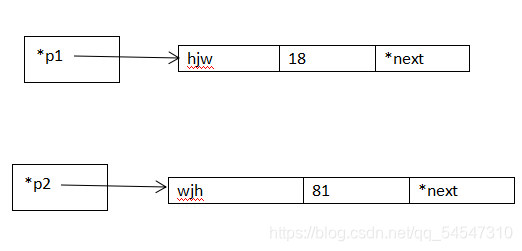数组和链表都可以存放数据,数组的格式如下
int a[3] = {
1,2,3};
| a[3] | data |
|---|---|
| a[0] | 1 |
| a[1] | 2 |
| a[2] | 3 |
然而对于数组来说,删除数组中指定为位置的元素,插入一个元素显得复杂且麻烦。人们想出利用一个结构 来使各种操作变得更加方便,这个结构便是链表。
链表各成分理解
1、头文件
头文件需要包含
#include<stdio.h>
#include<stdlib.h>
2、定义结构体
需要包含 数据域 和 指针域
数据域:可以是各种数据类型组合一起
指针域:通过指针来使各节点连接在一起,从而快速实现各种操作
typedef struct student
{
char name[100];int age;student *next; //也可以规范一点写成struct student *next
};
这就是很简单的单链表的一个节点,可以表示为

在做下一步操作之前,先理解两个操作
1、指针访问结构体中的数据。
当定义一个指针指向结构体时,例如:
student stu1={
"hjw",18}; //自定义结构体内容
student *p = &stu1; //指针指向结构体stu1的地址
操作 p->name 或者 p->age 为访问结构体中的数据,若 p->age=19 ,即直接修改了stu1的数据age为19。
代码如下
typedef struct student
{
char name[100];int age;student *next; //也可以规范一点写成struct student *next
}student;int main(void)
{
student stu1={
"hjw",18};student *p = &stu1;printf("%s,%d\n",p->name,p->age);p->age=19;printf("%d\n",p->age);return 0;
}
运行结果:
hjw,18
19--------------------------------
Process exited after 0.07111 seconds with return value 0
请按任意键继续. . .
2、分配储存空间
要想存入一个数据,则需要利用malloc函数来开辟新的空间。此时你并不知道需要开辟多大的空间。可以直接利用sizeof函数来确定你所需要的空间大小。
注意:使用malloc函数返回的是void*的指针,所以还需要强制转换为你所需要的类型。
若如上文我们所写的一样,需要强制转换成student*的类型,则如下所示
student *p1;
p1 = (student *)malloc(sizeof(student));
表示:指针 p1 指向 结构体student大小的 内存区域
3、创立第二个链表节点,并尝试连接起来
由第二点的操作,我们可以定义 两个指针 指向 两个结构体的内存区域 ,并通过这两个指针来进行 数据的修改等操作
先定义两个指针,并指向两个结构体的内存区域。student *p1,*p2;p1 = (student *)malloc(sizeof(student));p2 = (student *)malloc(sizeof(student));
再通过这两个指针进行数据的填充由于发现给了下标的数组不好赋值,我们可以利用指针字符串的方式定义名字把char name[100] 修改为 const char *name
即把结构体改为了typedef struct student
{
const char *name;int age;student *next; //也可以规范一点写成struct student *next
}student;
进行数据填充:p1->name = "hjw";p1->age= 18 ;p2->name = "wjh";p2->age = 81;检测一下是否填充成功 printf("%s %d\n",p1->name,p1->age);printf("%s %d\n",p2->name,p2->age);运行结果为
hjw 18
wjh 81--------------------------------
Process exited after 0.05025 seconds with return value 0
请按任意键继续. . .
此时用图表示为

再把这两个链表连接在一起
p1->next = p2;

这就是最简单的链表。
要想做更多操作,则需要把 头链表 以及 尾结点 给记录起来。
student *head;
head = p1;
把头链表 p1 的位置记录给 head 。
p2->next = NULL;
把尾结点给标记为NULL,即进行操作时,可以通过这个终止操作。
表示为:
这便是最简单的链表,此时已经实现了连接的操作了
利用循环语句,实现多链表的连接
直接上源代码:
#include<stdio.h>
#include<stdlib.h>typedef struct student
{
const char *name;int age;student *next; //也可以规范一点写成struct student *next
}student;int main(void)
{
student *p;student *head;student *p1,*p2;head = 0;for(int i=0;i<=5;i++){
p1 = (student *)malloc(sizeof(student));//p1指向开辟一个内存p1->age = i; //数据的插入if(head == 0) //用if条件句判断head是否指向头链表{
head = p1;p2 = p1;}else //head已经标记头链表了{
p2->next = p1; //p2用来标记上一次的内存,把上一个内存的next指向下一个 p2 = p1; //p2为下次的连接做准备}}p1->next = NULL;p = head; //p指向头链表,方便操作while(p != NULL){
printf("%d ",p->age);p = p->next ;}return 0;
}
运行结果:0 1 2 3 4 5
--------------------------------
Process exited after 0.03945 seconds with return value 0
请按任意键继续. . .
下面开始解释一些常见的链表操作
输入数据并连接链表
输入数据:p1 = (student *)malloc(sizeof(student));scanf("%s",p1->name);scanf("%d",&p1->age)再设置循环语句,连接链表if(head == 0){
head = p1;p2 = p1;}else{
p2->next = p1;p2 = p1;}
标记一个变量,使输入数据可以结束循环。直接上代码:
#include<stdio.h>
#include<stdlib.h>typedef struct student
{
char name[20];//改为数组int age;student *next; //也可以规范一点写成struct student *next
}student;int main(void)
{
student *p;student *head;student *p1,*p2;head = 0;char q;while(1){
printf("continue?(y/n)\n");scanf("%c",&q);if(q=='y'){
p1 = (student *)malloc(sizeof(student));printf("your name:");scanf("%s",p1->name);printf("age:");scanf("%d",&p1->age);getchar();if(head == 0){
head = p1;p2 = p1 ;}else{
p2->next = p1;p2 = p1;}}else{
break;}}p1->next = NULL;p = head;printf("%s:%d",p->name,p->age);p=p->next;printf("%s:%d",p->name,p->age);return 0;
}
删除链表
三个节点,第一个节点直接连接到第三个节点上,释放第二个链表的内存。释放内存的函数为free()。
原理图:

--------------------------------------------------------------------------------------------------------------------------

即完成了删除链表的操作。
查找链表(删除特定的链表)
利用while等循环语句,遍历链表直至查到所需要的数据位置。
1.通过学号或者年龄等数据查询
例如通过年龄来查询
int a;
scanf("%d",&a);
while(p->age != a ) //当年龄符合要求时,退出循环
{
p = p->next; //p循环一次都会向下移动一个链表
}
怎么查询多个同一年龄的人呢?可以改进为:
int a;
scanf("%d",&a);
while(p->age != a || p != NULL)
{
if(p->age == a){
printf("%s:%d",p->name,p->age);}p = p->next;
}
2.通过数组中的元素查询,例如名字
可以借助关于 字符串 的函数来实现。例如strcmp()
字符串比较函数strcmp的比较,两个字符串自左向右逐个字符相比(按ASCII值大小相比较),直到出现不同的字符或遇’\0’为止。基本形式为strcmp(str1,str2),若str1=str2,则返回零,若str1<str,,则返回负数;若str1>str2,则返回正数。
char a[20];
scanf("%s",a);
while(!strcmp(a,p->name) || p != NULL)
{
if(!strcmp(a,p->name)){
printf("%s:%d",p->name,p->age);}p = p->next;
}
还有更多进阶操作,以后更新。新人刚学编程,如有错误可以和我说一下,大家可以帮忙点个赞吗?